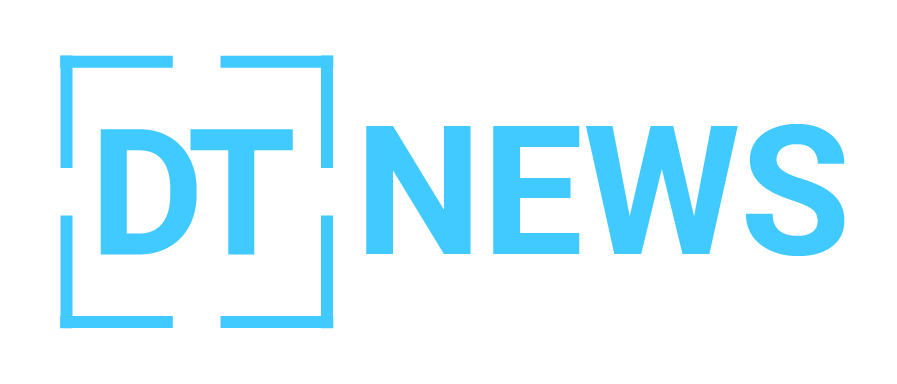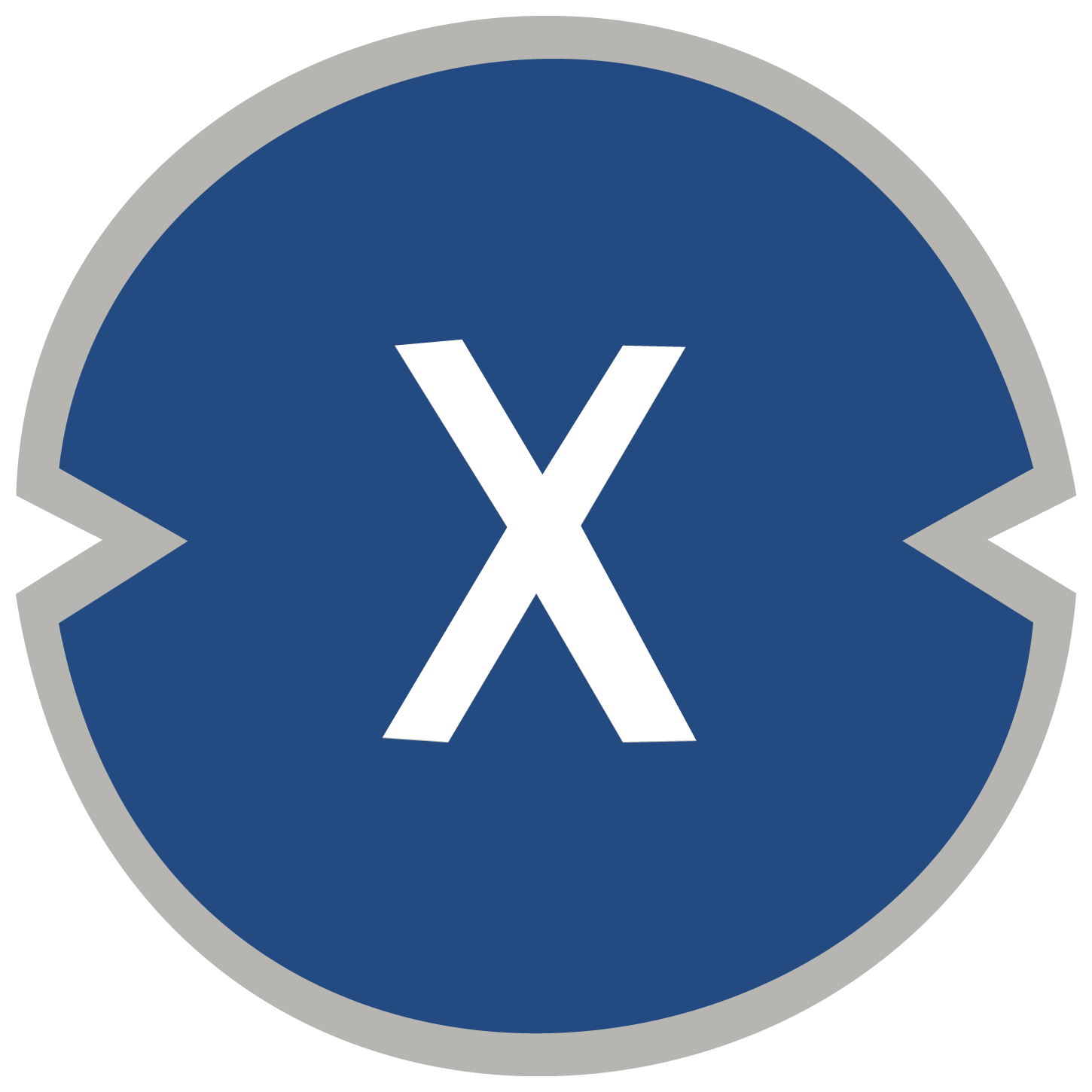Web3 technologies have seen explosive growth in recent years, but mass adoption has remained elusive. However, LINE NEXT, the Web3 venture from LINE, one of Asia’s largest messaging platforms, has launched a game-changing initiative poised to change this dynamic. By integrating decentralized applications (Dapps) directly into its popular messaging app, LINE aims to make Web3 services more accessible and drive widespread adoption in Asia.
With a mission to introduce over 1,000 blockchain-based applications by the end of 2025, LINE NEXT is laying the groundwork for a massive Web3 ecosystem. Here’s a detailed look into LINE NEXT’s ambitious plan, the significance of its Mini Dapps, and its potential to revolutionize how users interact with blockchain technology.
LINE NEXT’s Vision for Web3
A Platform for All: Accessibility and Usability
LINE NEXT’s initiative revolves around the concept of Mini Dapps, lightweight decentralized applications accessible through the LINE messaging app. These apps cover a variety of use cases, including gaming, social media, healthcare, and wellness. Powered by Kaia, a Layer 1 blockchain developed in partnership with Kakao, LINE NEXT aims to make Web3 services both accessible and user-friendly.
The emphasis on accessibility stems from the realization that most users find traditional blockchain platforms intimidating. Mini Dapps aim to bridge this gap by offering services that integrate seamlessly into a familiar environment. For instance, users don’t need to navigate external wallets or complicated onboarding processes; instead, they can interact with blockchain-powered services directly within the LINE app.
This approach has the potential to bring Web3 to millions who might otherwise remain hesitant about engaging with blockchain technology. Additionally, LINE NEXT’s integration with the Kaia blockchain ensures that transactions are fast, secure, and scalable, addressing common challenges associated with decentralized systems.
Dapp Portal: The Gateway to Web3
In addition to Mini Dapps, LINE NEXT has launched Dapp Portal, a dedicated platform that acts as a gateway for users to explore and interact with decentralized applications. The portal simplifies the discovery process, enabling users to find Dapps tailored to their interests, whether they are gaming enthusiasts, social media users, or fitness aficionados.
Beyond exploration, Dapp Portal also facilitates asset trading, including NFTs. By integrating a marketplace directly into the platform, LINE NEXT offers users a comprehensive Web3 experience, making it easier for them to engage with blockchain technology without needing to leave the ecosystem. This seamless integration reflects LINE NEXT’s commitment to reducing friction in the user journey.
The First Batch of LINE Mini Dapps
LINE NEXT’s initial rollout includes an exciting lineup of Mini Dapps that highlight the platform’s potential:
- Captain Tsubasa -RIVALS-:
A blockchain-based game inspired by the beloved Japanese manga Captain Tsubasa. This game taps into the nostalgia of fans while introducing them to blockchain-based gaming mechanics, such as earning rewards and trading in-game assets. - Superz:
A healthcare and wellness app that uses blockchain to incentivize users to achieve fitness goals and maintain healthy habits. By gamifying wellness, Superz aims to attract a wide demographic of users.

These apps represent just the tip of the iceberg. With plans to launch over 1,000 Dapps by 2025, LINE NEXT is setting the stage for an expansive ecosystem that caters to diverse interests.
Why Mini Dapps Matter for Web3 Adoption
Lessons from Telegram’s Success
LINE NEXT’s initiative draws inspiration from Telegram’s integration of Dapps on its TON blockchain. In 2024, Telegram introduced games like Notcoin and Hamster Kombat, which skyrocketed the network’s user base from 4 million to 128 million in a single year. By embedding Dapps into its platform, Telegram demonstrated how a popular messaging app can serve as a springboard for Web3 adoption.
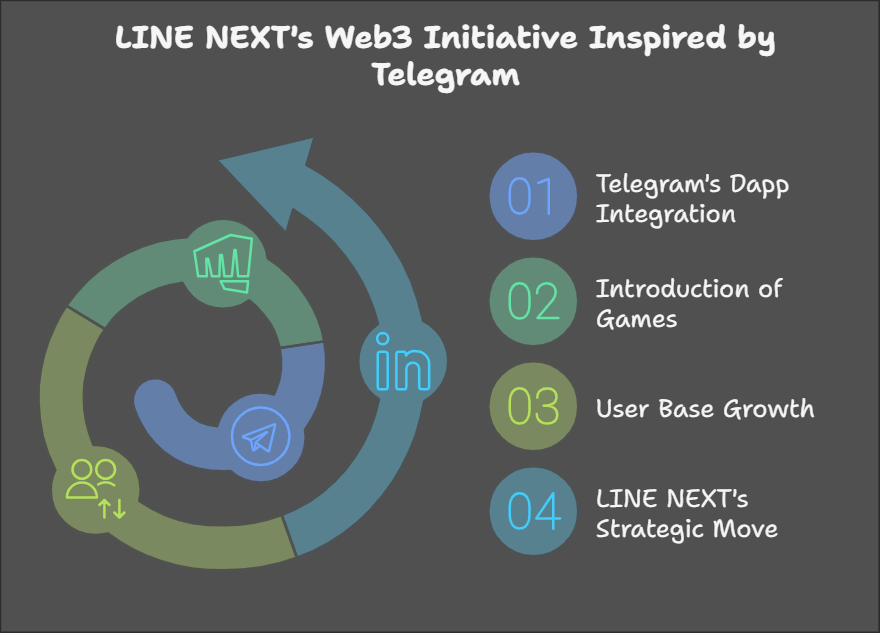
Similarly, LINE’s massive user base of approximately 200 million users, concentrated in Japan, Taiwan, and Thailand, gives it a strategic advantage. By leveraging this audience, LINE NEXT aims to replicate and even surpass Telegram’s success.
Accessibility: The Key to Mass Adoption
One of the most significant hurdles for Web3 services has been accessibility. While blockchain technologies offer immense potential, their steep learning curve often alienates casual users. LINE’s integration of Mini Dapps eliminates this barrier, enabling users to interact with Web3 services without leaving the app they already use daily.
Youngsu Ko, CEO of LINE NEXT, emphasized this point:
“A true popularization of Web3 services depends on their accessibility and usability. Mini Dapps based on LINE Messenger will become the first large-scale Web3 user adoption case in Asia.”
This strategy not only simplifies the user experience but also reduces resistance to trying new technologies. By making Web3 as intuitive as Web2, LINE NEXT is paving the way for widespread adoption.
The Strategic Importance of Asia
A Thriving Market for Blockchain Innovation
Asia has long been a hub for blockchain innovation, with countries like South Korea, Japan, and Singapore leading the way in crypto adoption. LINE, as a dominant messaging platform in Japan, Taiwan, and Thailand, is uniquely positioned to drive Web3 adoption in the region.
The region’s affinity for technology and innovation, combined with LINE’s popularity, creates a fertile ground for the growth of decentralized applications. According to a 2024 report by Chosun Ilbo, LINE’s active user base spans 200 million individuals globally, with a significant concentration in Asia. This vast audience provides an unparalleled opportunity to introduce Web3 technologies to millions of users who may not have otherwise engaged with blockchain services.
Moreover, Asia’s regulatory environment, while varied, has generally been supportive of blockchain innovation. Countries like Japan have established clear guidelines for crypto assets, making it easier for companies like LINE NEXT to operate and expand their offerings. By aligning its strategy with regional trends, LINE NEXT is well-positioned to capitalize on Asia’s growing interest in blockchain technologies.
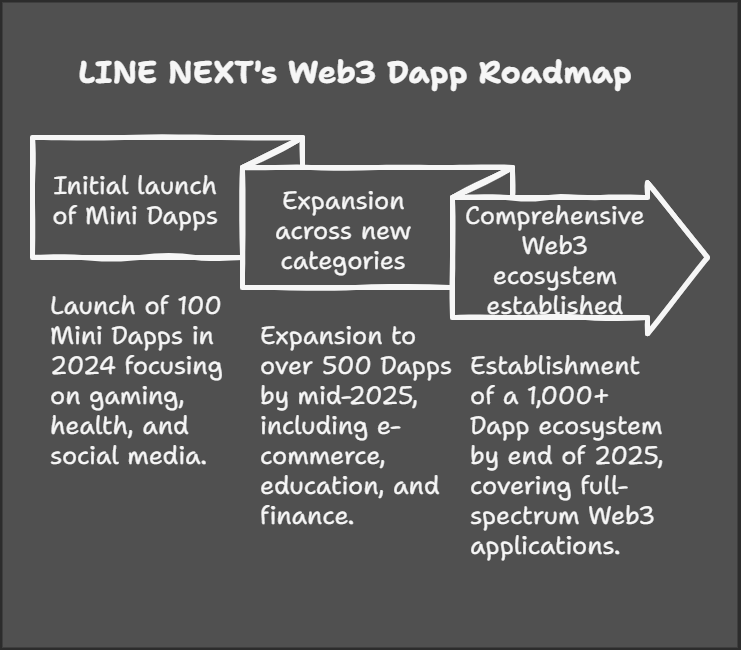
Future Outlook: 1,000+ Dapps by 2025
LINE NEXT’s goal of launching over 1,000 Dapps by the end of 2025 is ambitious, but it aligns with the rapid pace of blockchain development. These applications will span a wide range of categories, from finance and entertainment to education and e-commerce, creating a comprehensive Web3 ecosystem.
Expanded Table: LINE NEXT’s Dapp Roadmap
| Year | Milestone | Target Number of Dapps | Key Focus Areas |
| 2024 | Initial launch of Mini Dapps | 100 | Gaming, Health, Social Media |
| Mid-2025 | Expansion across new categories | 500+ | E-commerce, Education, Finance |
| End of 2025 | Comprehensive Web3 ecosystem established | 1,000+ | Full-spectrum Web3 applications |
Challenges and Opportunities
Potential Challenges
- Regulatory Uncertainty: As with any blockchain initiative, navigating regulatory landscapes in different countries remains a challenge for LINE NEXT.
- User Education: While Mini Dapps simplify the user experience, educating users about blockchain’s benefits and functionality is still essential.
Opportunities
- Partnerships: Collaborations with other tech giants, like LINE’s partnership with Kakao for the Kaia blockchain, can accelerate adoption.
- Monetization: The integration of NFTs and other digital assets offers new revenue streams for both LINE NEXT and its users.
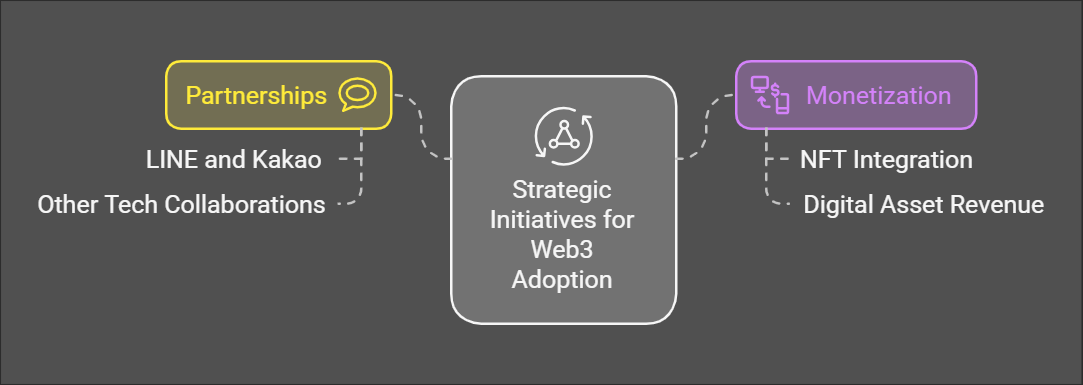
Conclusion: A New Era for Web3 in Asia
LINE NEXT’s introduction of Mini Dapps marks a pivotal moment for Web3 adoption in Asia. By leveraging its massive user base and integrating blockchain seamlessly into its messaging platform, LINE is setting a new standard for accessibility and usability in the Web3 space.
With a goal of launching over 1,000 Dapps by 2025, LINE NEXT is not just keeping pace with global blockchain trends but is actively shaping the future of decentralized applications. If successful, this initiative could serve as a blueprint for other platforms aiming to bridge the gap between Web2 and Web3.
For those watching the blockchain space, LINE NEXT’s ambitious roadmap is a development to follow closely. With its user-first approach and focus on accessibility, the platform has the potential to redefine what Web3 adoption looks like in the years to come.
FAQs About LINE NEXT’s Web3 Initiative
- What is LINE NEXT’s primary goal with its Web3 initiative?
LINE NEXT aims to introduce over 1,000 decentralized applications (Dapps) on its platform by the end of 2025. These applications, known as Mini Dapps, are designed to make blockchain technology accessible to a broader audience through the LINE messaging app. - What are Mini Dapps, and how do they work?
Mini Dapps are lightweight blockchain-based applications integrated into the LINE messaging app. They offer various services, including gaming, healthcare, and social media, allowing users to interact with Web3 technologies without leaving the app. - How does LINE NEXT’s Dapp Portal enhance the user experience?
The Dapp Portal acts as a gateway for users to explore and interact with Mini Dapps. It simplifies discovery, enables NFT trading, and provides a seamless way to engage with Web3 content within the LINE ecosystem. - What are some examples of Mini Dapps introduced by LINE NEXT?
The initial Mini Dapps include:- Captain Tsubasa -RIVALS-: A game inspired by the popular manga, featuring blockchain-based gameplay and in-game asset trading.
- Superz: A health and wellness Dapp that gamifies fitness goals and rewards users for healthy habits.
